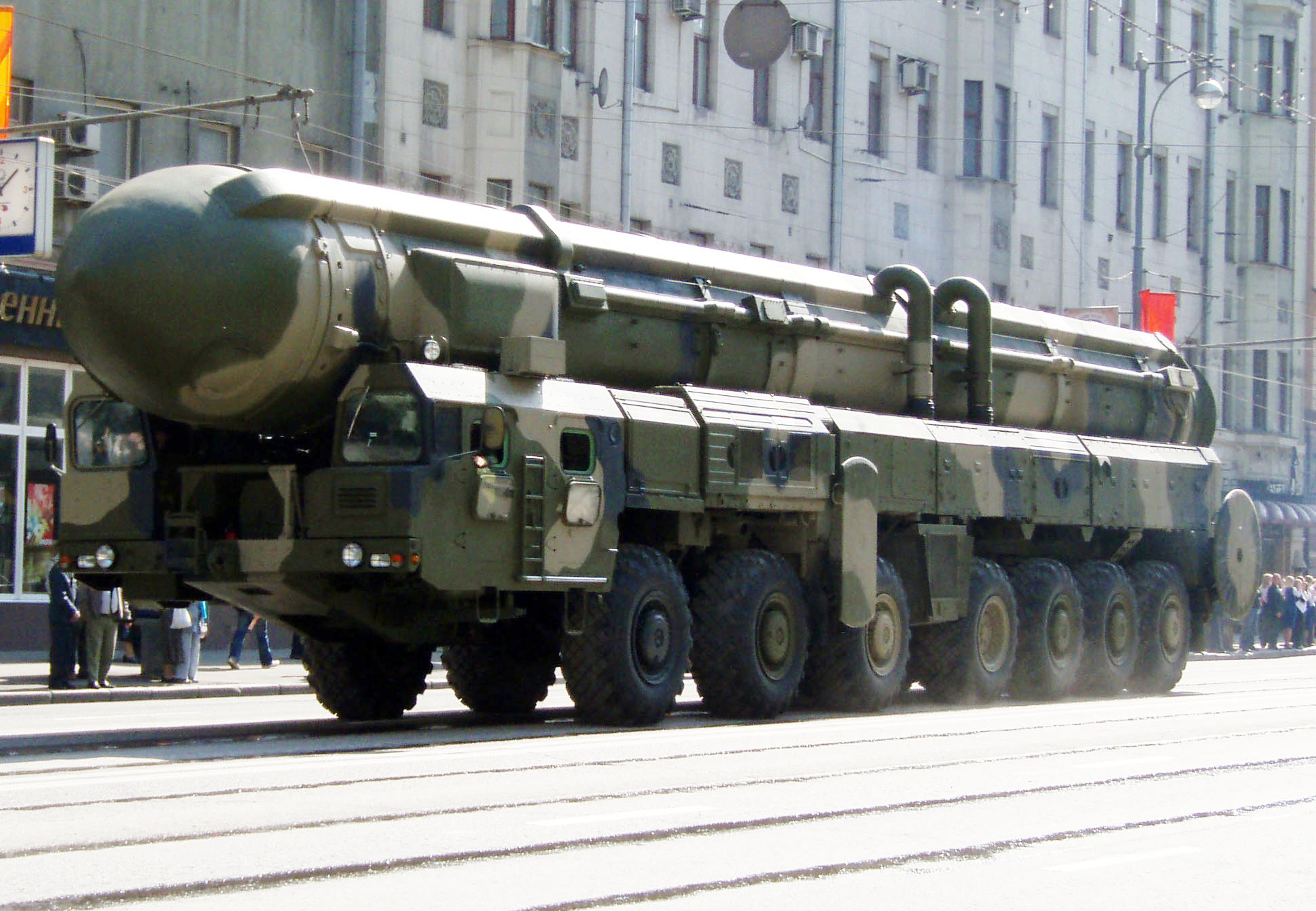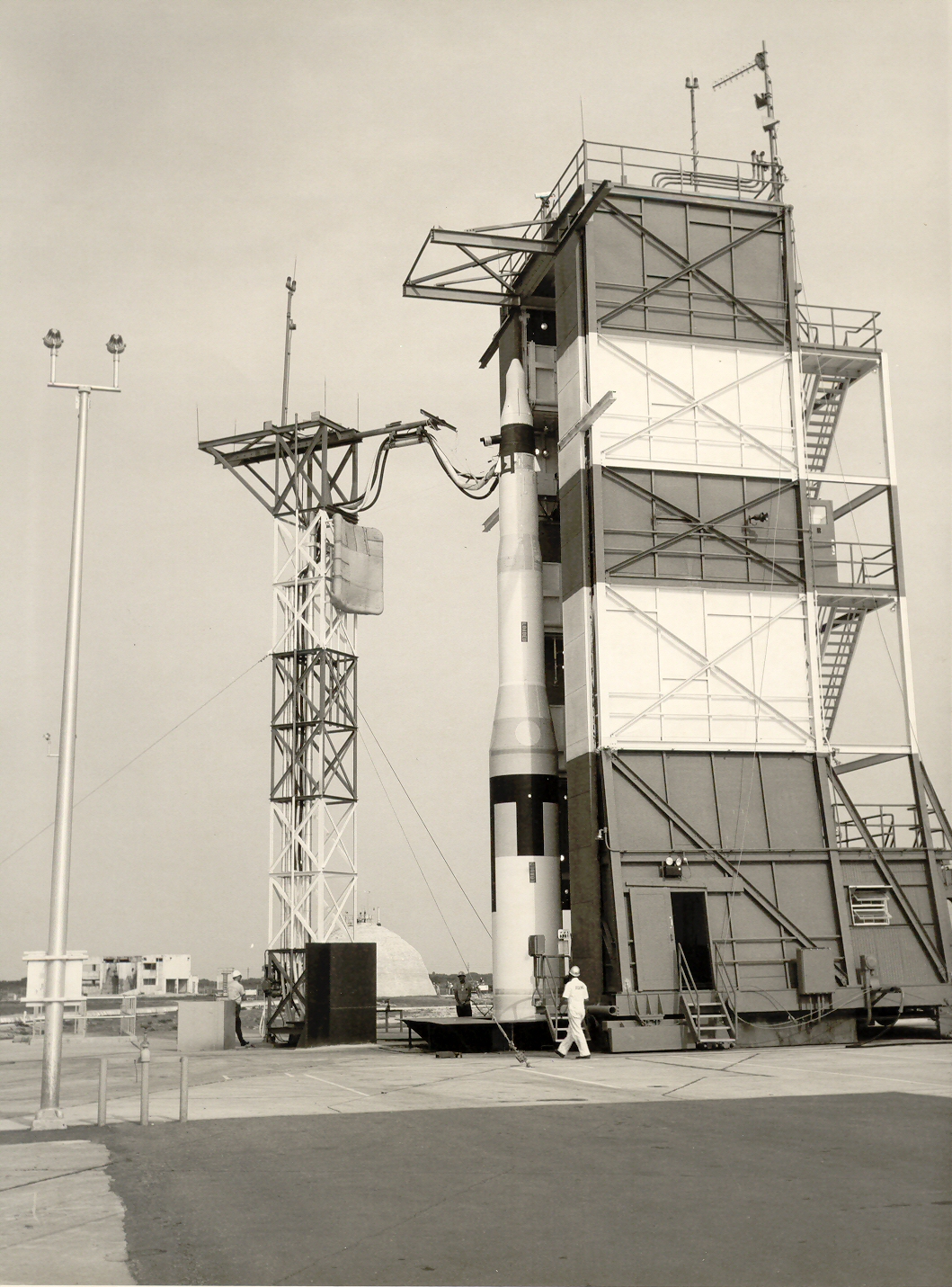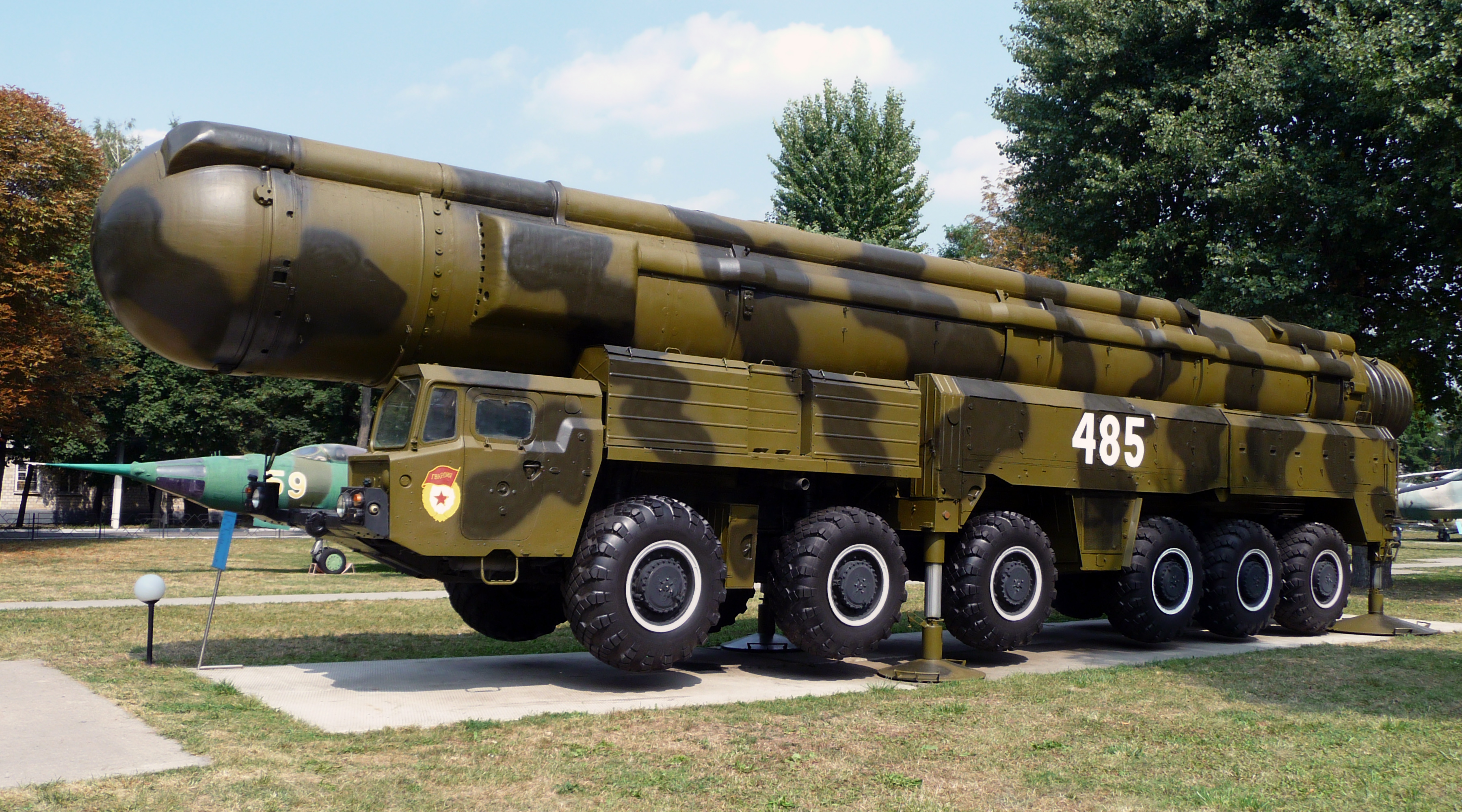|
RT-2PM Topol
The RT-2PM Topol (; NATO reporting name SS-25 Sickle; GRAU designation: 15Ж58 ("15Zh58"); START I designation: RS-12M Topol) was a mobile intercontinental ballistic missile designed in the Soviet Union and in service with Russia's Strategic Missile Troops. , Russia planned to replace all RT-2PM ICBMs with versions of Topol-M. In December 2023, the last Topol regiment was taken off combat duty. Development The three stage solid propellant RT-2PM Topol is an improved mobile ICBM which replaced earlier outdated missile complexes. It emerged from the same line of development as mobile missiles such as the RT-21 Temp 2S and the RSD-10 Pioneer, and was deployed as a replacement for the widely deployed UR-100. The United States considered developing their own road-mobile ICBM called the Midgetman, but the program was canceled with the end of the Cold War. Development of the RT-2PM was approved on 19 July 1977 and carried out by the Moscow Institute of Thermal Technology headed by A ... [...More Info...] [...Related Items...] OR: [Wikipedia] [Google] [Baidu] |
Soviet Union
The Union of Soviet Socialist Republics. (USSR), commonly known as the Soviet Union, was a List of former transcontinental countries#Since 1700, transcontinental country that spanned much of Eurasia from 1922 until Dissolution of the Soviet Union, it dissolved in 1991. During its existence, it was the list of countries and dependencies by area, largest country by area, extending across Time in Russia, eleven time zones and sharing Geography of the Soviet Union#Borders and neighbors, borders with twelve countries, and the List of countries and dependencies by population, third-most populous country. An overall successor to the Russian Empire, it was nominally organized as a federal union of Republics of the Soviet Union, national republics, the largest and most populous of which was the Russian SFSR. In practice, Government of the Soviet Union, its government and Economy of the Soviet Union, economy were Soviet-type economic planning, highly centralized. As a one-party state go ... [...More Info...] [...Related Items...] OR: [Wikipedia] [Google] [Baidu] |
Russia
Russia, or the Russian Federation, is a country spanning Eastern Europe and North Asia. It is the list of countries and dependencies by area, largest country in the world, and extends across Time in Russia, eleven time zones, sharing Borders of Russia, land borders with fourteen countries. Russia is the List of European countries by population, most populous country in Europe and the List of countries and dependencies by population, ninth-most populous country in the world. It is a Urbanization by sovereign state, highly urbanised country, with sixteen of its urban areas having more than 1 million inhabitants. Moscow, the List of metropolitan areas in Europe, most populous metropolitan area in Europe, is the capital and List of cities and towns in Russia by population, largest city of Russia, while Saint Petersburg is its second-largest city and Society and culture in Saint Petersburg, cultural centre. Human settlement on the territory of modern Russia dates back to the ... [...More Info...] [...Related Items...] OR: [Wikipedia] [Google] [Baidu] |
Topol LAS
Topol may refer to: Missiles * RT-2PM Topol, a Russian intercontinental ballistic missile in service from 1985 * RT-2PM2 Topol-M, a Russian intercontinental ballistic missile in service from 1997 People * Topol (surname) * Chaim Topol Chaim Topol (; 9 September 1935 – 8 March 2023), mononymously known as Topol, was an Israeli actor and singer. He is best known for his portrayal of Tevye, the lead role in the stage musical ''Fiddler on the Roof'' and the Fiddler on the Roof ..., Israeli actor known mononymously as Topol Places * Topol, Bloke, Slovenia, a settlement * Topol pri Begunjah, Slovenia, a village formerly named simply Topol * Topol pri Medvodah, Slovenia, a settlement formerly named Topol Other * Topol Show, a Czech web talk show hosted by former Czech Prime Minister Mirek Topolánek See also * * Topal (other) * Topo (other) * Topola (other) {{disambiguation, geo ... [...More Info...] [...Related Items...] OR: [Wikipedia] [Google] [Baidu] |
LGM-30 Minuteman
The LGM-30 Minuteman is an American land-based intercontinental ballistic missile (ICBM) in service with the Air Force Global Strike Command. , the LGM-30G (Version 3) is the only land-based ICBM in service in the United States and represents the land leg of the U.S. nuclear triad, along with the Trident II submarine-launched ballistic missile (SLBM) and nuclear weapons carried by long-range strategic bombers. Development of the Minuteman began in the mid-1950s when basic research indicated that a solid-fuel rocket motor could stand ready to launch for long periods of time, in contrast to liquid-fueled rockets that required fueling before launch and so might be destroyed in a surprise attack. The missile was named for the colonial minutemen of the American Revolutionary War, who could be ready to fight on short notice. The Minuteman entered service in 1962 as a deterrence weapon that could hit Soviet cities with a second strike and countervalue counterattack if the U.S. wa ... [...More Info...] [...Related Items...] OR: [Wikipedia] [Google] [Baidu] |
MAZ-7917
The MAZ-7917 () is a Soviet and Russian army 14×12 Twelve-wheel drive transporter-erector-launcher designed and developed by the Minsk Automobile Plant (MAZ) in Belarus. Developed primarily for use as a Topol ICBM mobile launcher, the earlier MAZ-7912 is similar in design to the MAZ-547A but has seven axle An axle or axletree is a central shaft for a rotation, rotating wheel and axle, wheel or gear. On wheeled vehicles, the axle may be fixed to the wheels, rotating with them, or fixed to the vehicle, with the wheels rotating around the axle. In ...s instead of six, including one dead axle. In the mid-1980s, the MAZ-7917 variant was introduced, with an additional length of and crew cabins similar to the MAZ-7916 - and at present, the 8-axle MZKT-79221 variant is used to carry the Topol M, Topol's replacement. See also * MAZ-7310 * KAMAZ-7850 External links * http://denisovets.ru/maz/mazpages/maz7917.html Military vehicles of the Soviet Union Self-prope ... [...More Info...] [...Related Items...] OR: [Wikipedia] [Google] [Baidu] |
MAZ-7310
The MAZ-543/MAZ-7310 "Uragan" (/Hurricane) is a Soviet/Belarusian 8×8 artillery truck designed and developed by MAZ (Minsk Automobile Plant), in what is now Belarus. MAZ-543 Designed in the 1960s, the MAZ-543 was presented on 7 November 1965 during the Moscow Red Square military parade as part of '' SS-1с Scud B'' (9K72 Elbrus) system. The vehicle is powered by a 38.9 litre D12A-525 tank diesel engine producing around 525 horsepower, and gives a maximum road speed of 37 mph (60 km/h). There have been a number of variants. MAZ-543A The 1967 MAZ-543A, arrived (with extra carrying capacity up to 22000 kg). The MAZ-7310 could operate together with 4WD MAZ-8385 trailer as a road-train (total length - 205.5 m) for oil surveying. It was used in Siberia and also as a tractor on military airbases. MAZ-543M The MAZ-543M version was designed to carry the BM-30 Smerch Multiple rocket launcher. MAZ-543P The MAZ-543P (carrying capacity - 19600 k ... [...More Info...] [...Related Items...] OR: [Wikipedia] [Google] [Baidu] |
Irkutsk
Irkutsk ( ; rus, Иркутск, p=ɪrˈkutsk; Buryat language, Buryat and , ''Erhüü'', ) is the largest city and administrative center of Irkutsk Oblast, Russia. With a population of 587,891 Irkutsk is the List of cities and towns in Russia by population, 25th-largest city in Russia by population, the fifth-largest in the Siberian Federal District, and one of the largest types of inhabited localities in Russia, cities in Siberia. Located in the south of the eponymous oblast, the city proper lies on the Angara River, a tributary of the Yenisei River, Yenisei, about 850 kilometres (530 mi) to the south-east of Krasnoyarsk and about 520 kilometres (320 mi) north of Ulaanbaatar. The Trans-Siberian Highway (Federal M53 and M55 Highways) and Trans-Siberian Railway connect Irkutsk to other regions in Russia and Mongolia. Many distinguished Russians were sent into exile in Irkutsk for their part in the Decembrist revolt of 1825, and the city became an exile-post for the ... [...More Info...] [...Related Items...] OR: [Wikipedia] [Google] [Baidu] |
Plesetsk Cosmodrome
Plesetsk Cosmodrome () is a Russian spaceport located in Mirny, Arkhangelsk Oblast, near the town of Plesetsk, from which it takes its name. Until 2025 and the commissioning of the Andøya Space, Andøya base in Norway, it was the only operational orbital spaceport in Europe and the northernmost spaceport in the world. Originally developed as an intercontinental ballistic missile (ICBM) site for the R-7 (missile), R-7 missile, its strategic location approximately north of Moscow was key to its selection. Due to its high latitude, Plesetsk is particularly suited for specific types of satellite launches, such as those into Molniya orbits, and historically served as a secondary launch facility. Most Soviet orbital launches were conducted from Baikonur Cosmodrome, located in the Kazakh SSR. However, following the dissolution of the Soviet Union, Baikonur became part of Kazakhstan, which began charging Russia to lease the land for its use. As a result, Plesetsk has seen significant ... [...More Info...] [...Related Items...] OR: [Wikipedia] [Google] [Baidu] |
Midgetman Missile
The MGM-134A Midgetman, also known as the Small Intercontinental Ballistic Missile, was an intercontinental ballistic missile developed by the United States Air Force. The system was mobile and could be set up rapidly, allowing it to move to a new firing location after learning of an enemy missile launch. To attack the weapon, the enemy would have to blanket the area around its last known location with multiple warheads, using up a large percentage of their force for limited gains and no guarantee that all of the missiles would be destroyed. In such a scenario, the U.S. would retain enough of their forces for a successful counterstrike, thereby maintaining deterrence. Overview The Midgetman grew out of a requirement expressed in the mid-1980s by the U.S. Air Force for a small ICBM which could be deployed on road vehicles. Fixed silos are inherently vulnerable to attack, and with the increasing accuracy of submarine-launched ballistic missiles there was a growing threat that the ... [...More Info...] [...Related Items...] OR: [Wikipedia] [Google] [Baidu] |
UR-100
The UR-100 () was an intercontinental ballistic missile (ICBM) developed and deployed by the Soviet Union from 1966 to 1996. UR () in its designation stood for Universal Rocket (). It was known during the Cold War by the NATO reporting name SS-11 Sego and internally by the GRAU index 8K84. The Strela and Rokot carrier rockets were based on it. The similar designation ''UR-100MR'' () actually refers to an entirely different missile, the MR-UR-100 Sotka (SS-17 Spanker). Description The UR-100 was a two-stage liquid-propellant lightweight ICBM. Initial versions carried a single warhead of 0.5 to 1.1 Mt yield, while later versions could carry three or six MIRV warheads. The missile was silo-launched. 15P784 silo design (by KBOM, ''Design Bureau of Common Machinery'', of V.P.Barmin) was greatly simplified in comparison to earlier missiles. Facilities consisted of hardened, unstaffed silos controlled by a single central command post. This was the first soviet ICBM (8K84M, ... [...More Info...] [...Related Items...] OR: [Wikipedia] [Google] [Baidu] |
RSD-10 Pioneer
The RSD-10 ''Pioneer'' ( tr.: ''raketa sredney dalnosti (RSD) "Pioner"''; ) was an intermediate-range ballistic missile with a nuclear warhead, deployed by the Soviet Union from 1976 to 1988. It carried GRAU designation 15Ж45 (''15Zh45''). Its NATO reporting name was SS-20 Saber. Its deployment was a major cause of NATO's 'Double-Track Decision', which led to the deployment of more medium-range nuclear weapons in Western Europe. The RSD-10 was withdrawn from service under the 1987 Intermediate-Range Nuclear Forces Treaty. Specifications The missile was high, in diameter and weighed 37.1 tons. It was based on two solid-fuel fiberglass clad stages of the RT-21 Temp 2S (SS-16 ''Sinner''), so it was also known as the RT-21M ''Pioneer''. The missile's range was from initially; the final model had a maximum range of possibly . Initially the missile was fitted with a single 1 megaton, 1.6 ton warhead. Later models could take one or two (and from 1980, three) additional 15 ... [...More Info...] [...Related Items...] OR: [Wikipedia] [Google] [Baidu] |
RT-21 Temp 2S
The RT-21 Temp 2S () was a mobile intercontinental ballistic missile developed by the Soviet Union during the Cold War. It was assigned the NATO reporting name SS-16 Sinner and carried the industry designation 15Zh42 (15Ж42). The RT-21 was the first mobile ICBM developed in the world. Its innovative concept and design were created by Alexander Nadiradze. The RSD-10 Pioneer and succeeding missile complexes relied on the RT-21 base concept and were used by Nadiradze for many of his later projects. The program became mired in a series of treaty complications, including questions regarding its use of theatre missile launchers. It is unlikely that the RT-21 ultimately reached deployment, and by the mid-1980s, the program had been scrapped. Its maximum period of storage on a launcher was 5 years, and preparation time for launch was 40 minutes. See also * Strategic Rocket Forces * SS-16 Temp-2S * RT-2PM Topol * RT-2PM2 Topol-M * RS-24 Yars * RS-26 Rubezh * RS-28 Sarmat * R-3 ... [...More Info...] [...Related Items...] OR: [Wikipedia] [Google] [Baidu] |






